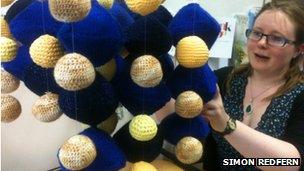New crystals yield solar power breakthrough
- Published

Dye-sensitised solar cells promise cheaper renewable energy
New materials technology has boosted the power conversion efficiency of cheap next-generation solar cells.
Called dye-sensitised solar cells (DSSCs), reported efficiencies of 15% make them competitive with silicon photovoltaic cells.
They create electricity from sunlight, mimicking the natural process of photosynthesis.
They are made at low temperature, work in low light, are transparent, and can be printed onto flexible surfaces.
The inventor of DSSCs, Professor Michael Graetzel of the École Polytechnique Fédérale de Lausanne (EPFL), Switzerland, announced in a paper in the journal Nature, a new two-step process for DSSC fabrication which raises the efficiency of these cells to 15%.
The technology uses a dye material called perovskite for energy-harvesting. It sits on a porous nanofilm of titanium dioxide (the stuff used to paint white lines on grass tennis courts) within the solar cell.
The Lausanne group has increased the efficiency by developing an improved method for crystallising the perovskite onto the titanium dioxide film.
DSSCs work well in cloudy weather and can absorb diffused sunlight and are relatively inexpensive to construct. The latest results suggest that they could significantly lower the price per watt of power produced by solar cells.
Dr James Ball, a researcher at the department of physics, University of Oxford - who was not involved in the work - commented: "The achievement of 15% efficiency is an important landmark and this technology provides the most efficient solution-processed solar cells by a long way. This development makes them competitive with silicon solar cells, but at much lower cost."
Perovskite project

Knitted molecular models offer their own challenges
Coincident with this news, promising cheap energy via perovskite dyes, is a celebration of the wider importance of the molecular structure of perovskite.
As well as lying at the heart of new solar cells, perovksite is the most abundant mineral in the rocky parts of our planet. It is the name given to a whole family of ceramic materials that are used in a huge number of modern technologies.
For example, perovskite is also used in mobile phone base stations, in rechargeable batteries, as magnetic sensors, microphone pickups, microchip components and even the humble gas lighter. Perovskite inventions abound.
Dr Julia Percival at University of Surrey Department of Chemistry has given the perovskite story a completely different take. Her "Perovskite Project" is an ambitious citizen science project. The project draws attention to the importance of perovskite in chemistry, physics, materials science and Earth sciences, and was instigated to mark last year's International Year of Chemistry and next year's International Year of Crystallography.
The Perovskite Project aims to build a knitted model of the molecular structure of perovskite. Knitters and crocheters from across the world can contribute to the model, with knitting patterns for perovskite molecules available to download, external.
They are collecting contributions through to the end of August and assembling the giant knitted perovskite later in the summer.
- Published10 July 2013
- Published8 July 2013
- Published28 October 2011